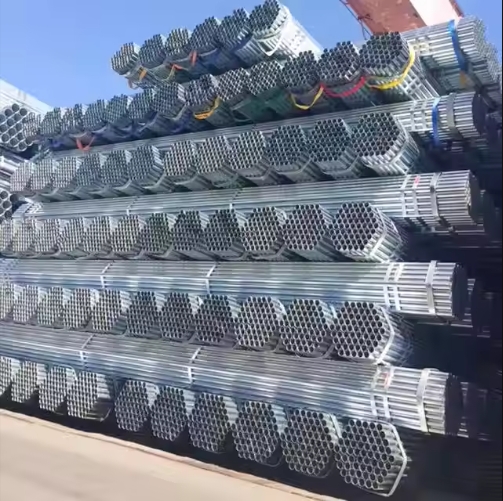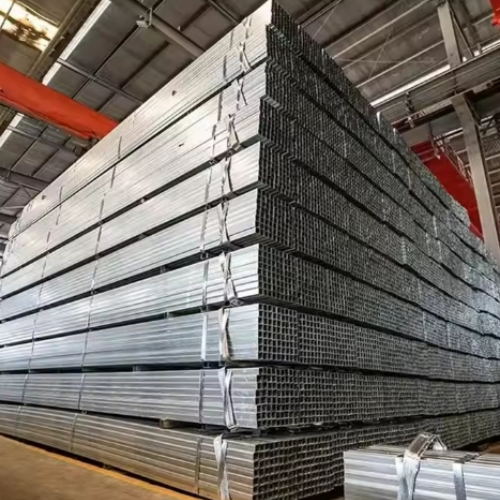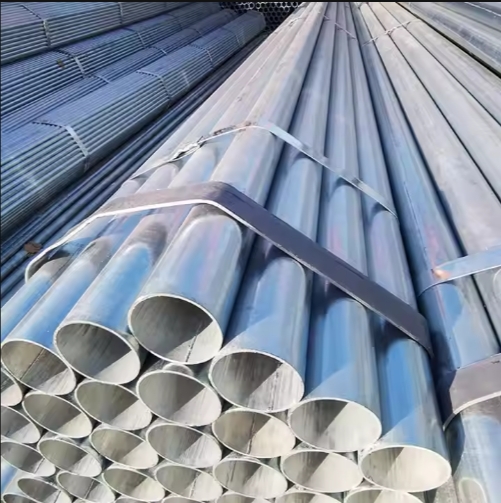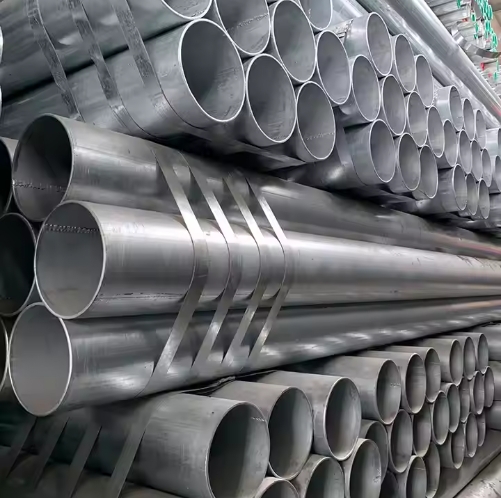National standard hot-dip galvanized steel pipes, DN15-DN200, zinc coating ≥80μm, dedicated to fire-fighting/greenhouse, factory direct supply.
Category:
Summary description:
Keywords:
Details
National standard hot-dip galvanized steel pipes, ranging from DN15 to DN200, with a zinc coating of at least 80μm, dedicated to fire-fighting and greenhouse applications, and available through factory direct supply, represent a pinnacle of specialized engineering in the realm of industrial and agricultural materials. These pipes are meticulously crafted to meet rigorous national standards, ensuring consistent performance, durability, and reliability across a spectrum of critical uses.
The DN15 to DN200 size range underscores the versatility of these hot-dip galvanized steel pipes. DN15, equivalent to a nominal diameter of 15 millimeters, is ideal for smaller-scale applications where precise fluid control is essential, such as in residential fire sprinkler systems or auxiliary greenhouse irrigation lines. On the other end of the spectrum, DN200 pipes, with a nominal diameter of 200 millimeters, are designed to handle high-volume flow, making them suitable for main fire water supply lines in commercial buildings or large-scale greenhouse climate control systems. This broad range ensures that whether the project requires a compact conduit or a robust pipeline, there is a size tailored to the specific needs, eliminating the inefficiencies of using oversized or undersized pipes.
A defining feature of these pipes is the zinc coating thickness of at least 80μm. This is not a arbitrary specification but a critical factor in ensuring long-term corrosion resistance. Hot-dip galvanization involves immersing the steel pipes in a bath of molten zinc, which bonds with the steel to form a protective layer. An 80μm coating is significantly thicker than many standard galvanized coatings, providing an enhanced barrier against rust, moisture, and chemical erosion. In fire-fighting applications, where pipes are often exposed to humid environments, frequent water flow, and occasional chemical treatments, this thick zinc layer prevents the formation of rust that could weaken the pipe walls over time. For greenhouses, which are typically exposed to constant moisture from irrigation, condensation, and outdoor weather conditions, the robust zinc coating resists corrosion caused by water, fertilizers, and pesticides, ensuring the structural integrity of the piping system for years.
The dedication to fire-fighting applications is evident in the pipes’ design and performance. Fire-fighting systems demand pipes that can withstand high pressure, rapid water flow, and extreme temperatures during emergencies. These national standard hot-dip galvanized steel pipes are engineered to meet these demands. The zinc coating, in addition to preventing corrosion, also adds a layer of heat resistance, allowing the pipes to maintain their structural stability even when exposed to the high temperatures of a fire. The uniformity of the galvanized layer, a result of adhering to national standards, ensures that there are no weak points in the pipe that could fail under pressure. This reliability is crucial in fire-fighting scenarios, where any failure in the piping system could lead to delayed response times, reduced water flow, and potentially catastrophic consequences.
For greenhouse applications, these pipes offer unique advantages that make them the preferred choice. Greenhouses operate in environments where moisture levels are high, and the presence of fertilizers and pesticides can create a corrosive atmosphere. The thick zinc coating of these pipes resists the chemical reactions caused by these substances, preventing degradation. Additionally, the structural strength of the steel, combined with the protective zinc layer, allows the pipes to serve multiple functions in greenhouses—from supporting the frame structure to transporting water for irrigation. The smooth internal surface of the pipes, a result of precise manufacturing, ensures unobstructed water flow, which is essential for delivering consistent irrigation to plants. This efficiency in water distribution helps optimize plant growth and reduces water waste, a key consideration for sustainable greenhouse operations.
The factory direct supply model is another significant benefit that adds value to these hot-dip galvanized steel pipes. By eliminating intermediaries, this supply chain approach ensures that customers receive products directly from the manufacturer, reducing costs and minimizing the risk of delays or quality issues. Factory direct supply also allows for greater transparency in the production process, as customers can communicate directly with the manufacturer to verify compliance with national standards, check production schedules, and address any specific requirements. For large-scale projects, such as equipping a new commercial building with fire-fighting pipes or constructing a sprawling greenhouse complex, this direct relationship ensures a steady and reliable supply of pipes, helping to keep projects on schedule and within budget.
Adherence to national standards is a cornerstone of these pipes’ quality and performance. National standards encompass a wide range of criteria, including material composition, manufacturing processes, dimensional accuracy, and coating thickness. By complying with these standards, the pipes ensure consistency in quality across all batches. This is particularly important for fire-fighting systems, which are subject to strict regulatory inspections and certifications. Using pipes that meet national standards ensures that the fire-fighting system will pass these inspections, providing building owners and occupants with the assurance that the system is reliable. For greenhouses, compliance with national standards ensures that the pipes are safe for use in environments where they may come into contact with food crops, as the zinc coating is non-toxic and meets safety guidelines for agricultural applications.
The durability of these pipes translates to long-term cost savings. While the initial investment in hot-dip galvanized steel pipes with an 80μm coating may be higher than that of uncoated or lightly coated pipes, the extended service life more than offsets this cost. In fire-fighting systems, the reduced need for repairs and replacements minimizes maintenance expenses and avoids the disruptions caused by system downtime. For greenhouses, which are often operational year-round, the longevity of the pipes means fewer interruptions to irrigation and structural support, ensuring continuous plant growth and productivity. Additionally, the resistance to corrosion reduces the risk of leaks, which can lead to water damage, mold growth, and crop loss in greenhouses, further adding to the cost-effectiveness of these pipes.
The versatility of the DN15-DN200 range allows for customization in various projects. DN15 pipes can be used for small-scale fire sprinkler heads or individual plant irrigation lines in greenhouses. DN50 to DN100 pipes are suitable for main water supply lines in mid-sized buildings or larger greenhouse sections. DN200 pipes, on the other hand, are ideal for industrial fire-fighting mains or central water distribution systems in large agricultural complexes. This flexibility ensures that engineers, contractors, and greenhouse operators can select the exact size needed, optimizing both performance and cost. The availability of multiple sizes also simplifies the integration of these pipes into existing systems, whether for upgrades or expansions.
In terms of installation, these hot-dip galvanized steel pipes offer ease of use. The uniform dimensions, a result of national standard compliance, ensure a perfect fit with standard fittings, such as elbows, tees, and valves, reducing installation time and effort. The smooth external surface of the pipes, thanks to the galvanization process, makes them easy to handle and maneuver during installation, even in tight spaces common in fire-fighting system installations or greenhouse structures. This ease of installation not only saves time but also reduces labor costs, making the pipes a practical choice for both large and small projects.
Environmental considerations are also addressed by these pipes. The hot-dip galvanization process is environmentally friendly compared to other coating methods, as it does not involve the use of harmful solvents. The zinc used in the coating is a naturally occurring element that is fully recyclable, and at the end of the pipes’ service life, they can be recycled, reducing waste and contributing to a circular economy. For greenhouse operators committed to sustainable farming practices, using recyclable materials aligns with their environmental goals, enhancing the overall sustainability of their operations.
In conclusion, national standard hot-dip galvanized steel pipes, ranging from DN15 to DN200 with a zinc coating of at least 80μm, dedicated to fire-fighting and greenhouse applications, and available through factory direct supply, are a testament to the fusion of quality, functionality, and practicality. They meet the stringent demands of fire-fighting systems with their high pressure resistance and corrosion protection, while serving the unique needs of greenhouses with their durability in moist and chemical-rich environments. The factory direct supply model ensures accessibility and cost-effectiveness, while adherence to national standards guarantees reliability and compliance. Whether protecting lives and property in fire emergencies or supporting sustainable agriculture in greenhouses, these pipes stand as a reliable and essential component, offering long-term performance and value for a wide range of applications.
More Products
Message

All Rights Reserved Copyright © RIZHAO STEEL HOLDING GROUP CO.,LTD. SEO 【Business license】
All Rights Reserved Copyright © RIZHAO STEEL HOLDING GROUP CO.,LTD.




















